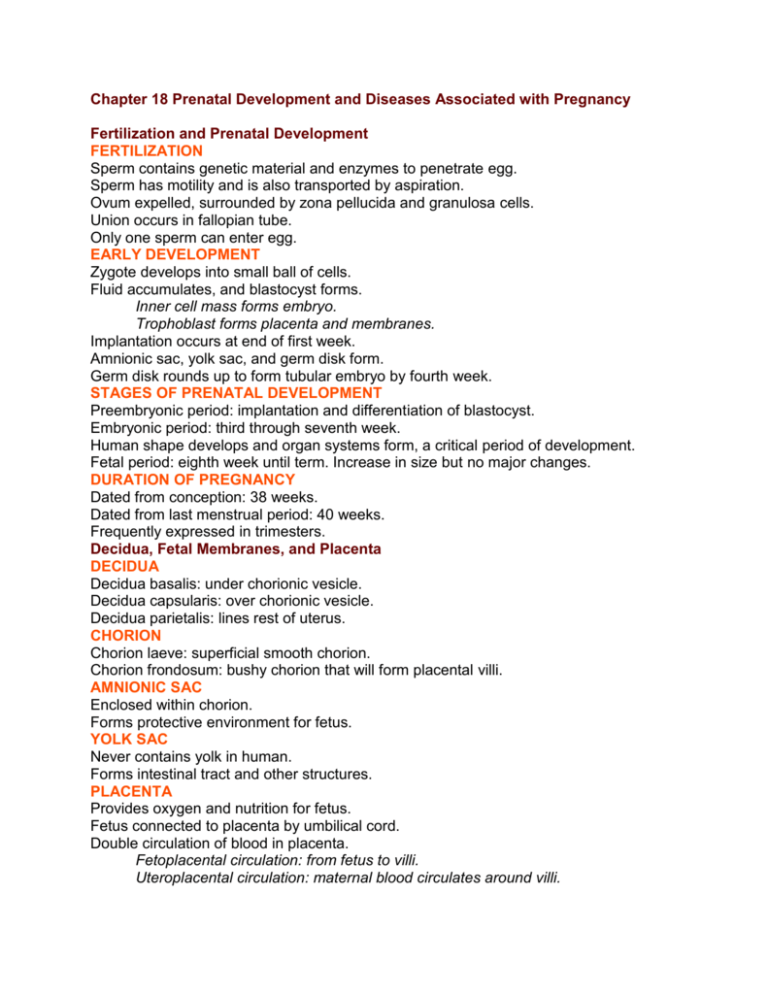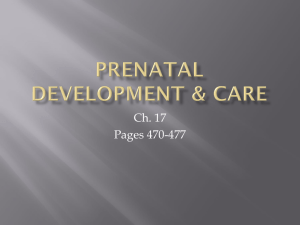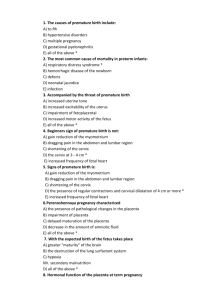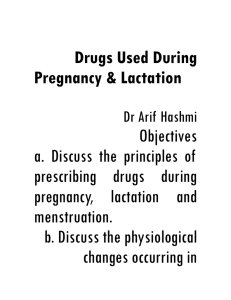Chapter 18 Prenatal Development and Diseases Associated with
advertisement

Chapter 18 Prenatal Development and Diseases Associated with Pregnancy Fertilization and Prenatal Development FERTILIZATION Sperm contains genetic material and enzymes to penetrate egg. Sperm has motility and is also transported by aspiration. Ovum expelled, surrounded by zona pellucida and granulosa cells. Union occurs in fallopian tube. Only one sperm can enter egg. EARLY DEVELOPMENT Zygote develops into small ball of cells. Fluid accumulates, and blastocyst forms. Inner cell mass forms embryo. Trophoblast forms placenta and membranes. Implantation occurs at end of first week. Amnionic sac, yolk sac, and germ disk form. Germ disk rounds up to form tubular embryo by fourth week. STAGES OF PRENATAL DEVELOPMENT Preembryonic period: implantation and differentiation of blastocyst. Embryonic period: third through seventh week. Human shape develops and organ systems form, a critical period of development. Fetal period: eighth week until term. Increase in size but no major changes. DURATION OF PREGNANCY Dated from conception: 38 weeks. Dated from last menstrual period: 40 weeks. Frequently expressed in trimesters. Decidua, Fetal Membranes, and Placenta DECIDUA Decidua basalis: under chorionic vesicle. Decidua capsularis: over chorionic vesicle. Decidua parietalis: lines rest of uterus. CHORION Chorion laeve: superficial smooth chorion. Chorion frondosum: bushy chorion that will form placental villi. AMNIONIC SAC Enclosed within chorion. Forms protective environment for fetus. YOLK SAC Never contains yolk in human. Forms intestinal tract and other structures. PLACENTA Provides oxygen and nutrition for fetus. Fetus connected to placenta by umbilical cord. Double circulation of blood in placenta. Fetoplacental circulation: from fetus to villi. Uteroplacental circulation: maternal blood circulates around villi. No normal intercommunication between circulations. Endocrine function of placenta: Makes estrogen and progesterone. Makes HCG and HPL. Pregnancy tests detect HCG. Amnionic Fluid FORMATION AND EXCRETION Chiefly a filtration from maternal blood early in pregnancy. Mostly fetal urine later in pregnancy. Fetus swallows fluid, which is absorbed, transferred to maternal circulation, and excreted by mother. Normally, balance maintained between secretion and excretion of fluid. POLYHYDRAMNIOS Fetus unable to swallow; thus, fluid accumulates in sac. Congenital obstruction of fetal upper intestinal tract; thus, fluid cannot be absorbed from intestinal tract. OLIGOHYDRAMNIOS Fetal kidneys fail to develop: no urine formed. Congenital obstruction of urethra: no urine escapes into amnionic fluid. Hormone-Related Conditions Associated with Pregnancy NAUSEA AND VOMITING OF EARLY PREGNANCY HYPEREMESIS GRAVIDARUM GESTATIONAL DIABETES Hyperglycemia harmful to developing fetus. Pregnancy hormones induce maternal insulin resistance. Diabetes results from inability to increase insulin secretion to compensate for insulin resistance. Identification by screening and treatment same as for nongestational diabetes. Usually diabetes relents after delivery. Spontaneous Abortion INCIDENCE Occurs in 10 to 20 percent of all pregnancies. Early abortion often as a result of chromosomal abnormalities incompatible with survival, or defective implantation. Late abortions usually caused by detachment of placenta or obstruction of blood supply through cord. Cocaine abuse disturbs blood flow to placenta and may cause placental abruption and intrauterine fetal death. COMPLICATIONS Disseminated intravascular coagulation syndrome: see Chapter 12. Ectopic Pregnancy PREDISPOSING FACTORS OF TUBAL PREGNANCY Previous tubal infection. Disturbed tubal motility. Frequently both fallopian tubes predisposed. CONSEQUENCES Tube ruptures within a few months. May cause profuse bleeding from torn blood vessels. Pregnancy Subsequent to Failure of Artificial Contraception FAILURE OF CONTRACEPTIVE PILLS Pills effective if used properly. Synthetic estrogens, progestins in pills may induce congenital abnormalities in developing embryo. FAILURE OF INTRAUTERINE DEVICE (IUD) Predisposes to infection. Remove IUD as soon as pregnancy diagnosed. Advise patient of risks if IUD cannot be removed. Abnormal Attachment of Umbilical Cord and Placenta VELAMENTOUS INSERTION OF CORD Cord attaches to membranes, and vessels must travel in membranes to reach placenta. Vessels may tear or be compressed during labor; may be fatal to infant, but no effect on mother. PLACENTA PREVIA Central placenta previa: placenta covers entire cervix. Partial placenta previa: margin of placenta covers cervix. Causes episodes of bleeding late in pregnancy. Hazardous to both mother and infant. Cesarean section delivery required. Twins and Multiple Pregnancies TWIN TRANSFUSION SYNDROME Vascular anastomoses connect placental circulations of identical twins. One twin may receive excess blood while the other becomes anemic. Minor disproportions in blood may be tolerated, but severe disproportions may be fatal to both twins. VANISHING TWINS AND BLIGHTED TWINS More twin conceptions than survivals to term. One twin dies and is either completely absorbed (vanishing twin) or persists as a degenerated fetus (blighted twin). CONJOINED (SIAMESE) TWINS Variable union between identical twins. Separation often not possible after birth. DISADVANTAGES OF TWIN PREGNANCY Twins smaller for gestational age. Premature onset of labor. Higher incidence of congential malformations. Twin transfusion syndrome. Preeclampsia and Eclampsia: Toxemia of Pregnancy Hydatidiform Mole and Choriocarcinoma GESTATIONAL TROPHOBLAST DISEASE Three categories: “benign” hydatidiform mole, invasive mole, and choriocarcinoma. Moles related to abnormal fertilization of a defective ovum. Villi form cystic structures. Invasive mole invades uterine wall. Moles treated by emptying the uterus. Chemotherapy if mole recurs. Choriocarcinoma is malignant, consists of neoplastic trophoblast without villi, and is treated by anticancer chemotherapy. Hemolytic Disease of the Newborn PATHOGENESIS AND CLINICAL MANIFESTATIONS Infant sensitizes mother to blood group antigen. Maternal antibody damages fetal cells. Infant increases blood production to compensate. Variable severity. Hydrops fetalis: severe anemia and edema. Anemia and jaundice. Mild disease with few symptoms. CHANGES IN HEMOGLOBIN AND BILIRUBIN AFTER DELIVERY Anemia increases because blood destruction continues and compensatory hematopoiesis declines. Jaundice develops because of inefficient excretion of bilirubin by newborn infant’s liver. Severe jaundice causes brain damage (kernicterus). Rh Hemolytic Disease THE RH SYSTEM Determined by series of allelic genes. Individual whose red cells contain D antigen is Rh positive. May be homozygous or heterozygous. Most cases of Rh hemolytic disease as a result of Rhnegative mother with Rh-positive infant. Rarely occurs in first pregnancy. DIAGNOSIS OF HEMOLYTIC DISEASE Blood group differences between mother and infant (e.g., mother Rh negative and fetus Rh positive). Mother has formed antibodies (e.g., anti-D). Antibody coats infant’s cells (positive direct Coombs test). Evidence of increased blood destruction. TREATMENT OF HEMOLYTIC DISEASE Exchange transfusion. Provides population of cells not attacked by maternal antibody. Provides plasma low in bilirubin. Does not change infant’s blood type. Fluorescent light therapy. Converts unconjugated bilirubin into less toxic compound. Reduces need for exchange transfusion. Intrauterine fetal transfusion. Used to salvage infants who would die prior to delivery. Blood instilled into fetal peritoneal cavity or umbilical cord using special techniques. PREVENTION OF RH HEMOLYTIC DISEASE Rh immune globulin administered to mother eliminates antigenic fetal cells. Incidence of Rh hemolytic disease greatly reduced. Not 100 percent effective. Some physicians recommend injections late in pregnancy as well as after delivery to further reduce incidence of sensitization. ABO HEMOLYTIC DISEASE Fetal A or B antigens stimulate maternal ABO antibodies. Causes mild hemolytic disease. May be encountered in first pregnancy.








